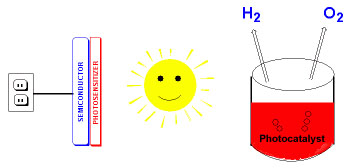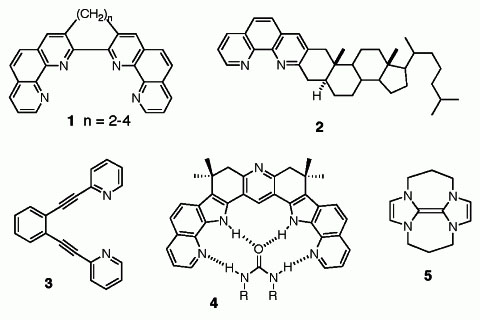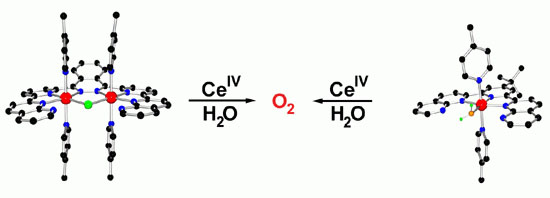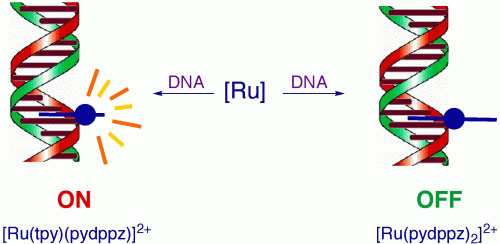Faculty Profile
 Randolph Thummel
Randolph Thummel
Professor Emeritus
Department of Chemistry
Office: SERC, 5020
Contact: thummel@uh.edu - 713-743-2734
Education: Ph.D., University of California, Santa Barbara, 1971; B.S., Brown University, 1967
Organic and Inorganic Chemistry
 Our main research interest is the design and synthesis of novel ligand systems and
the careful study of their coordination chemistry and the properties of their metal
complexes. We concentrate primarily on ligands involving azaaromatic nuclei such as
pyridine and pyrrole (1 – 5). These ligands are synthesized using a wide variety of
techniques ranging from the Friedländer condensation to Stille couplings. A popular
family of ligands involves 2,2'-bipyridine, terpyridine, and 1,10-phenanthroline.
We use steric, conformational, and electronic effects to modify the properties of
these ligands and in this manner we tune the properties of their corresponding metal
complexes.
Our main research interest is the design and synthesis of novel ligand systems and
the careful study of their coordination chemistry and the properties of their metal
complexes. We concentrate primarily on ligands involving azaaromatic nuclei such as
pyridine and pyrrole (1 – 5). These ligands are synthesized using a wide variety of
techniques ranging from the Friedländer condensation to Stille couplings. A popular
family of ligands involves 2,2'-bipyridine, terpyridine, and 1,10-phenanthroline.
We use steric, conformational, and electronic effects to modify the properties of
these ligands and in this manner we tune the properties of their corresponding metal
complexes.

Most of our work is aimed at the development of new photosensitizer molecules for solar energy utilization or biomedical applications. Our projects fall roughly into three categories and are funded by three Federal grants as well as a grant from the Robert Welch Foundation. One project involves using sunlight to photochemically decompose water into hydrogen and oxygen. We have prepared a series of dinuclear Ru(II) complexes that, upon exposure to a sacrificial chemical oxidant (CeIV), very efficiently oxidizes water to dioxygen. We were surprised to find that this process can be accomplished even more efficiently by a mononuclear catalyst and we have proposed a mechanism to explain these observations. Ongoing work is aimed at better understanding these catalytic processes and also optimizing the catalyst. Furthermore we hope to drive this reaction with light and are also examining a corresponding hydrogen evolution catalyst in collaboration with scientists at Brookhaven National Lab.
A second application for a photosensitizer in solar energy utilization involves photovoltaics through the design of dye-sensitized solar cells. We are developing a solid state, combinatorial approach to the synthesis of photosensitizers directly on the surface of a titanium dioxide semiconductor. We have also developed new sensitizers based on 1,8-naphthyridine ligands and Bodipy dyes. Thin film solar cells are constructed and evaluated for their incident photon to current efficiencies.

A third area of interest involves the interaction of transition metal complexes with DNA. We are examining two general classes of complex. The first class involves tridentate analogs of the intensely studied dppz (dipyridophenazine) molecule (pydppz). We have found that these complexes bind to DNA by intercalation and demonstrate the so-called “light switch” effect. In aqueous environment they are non-luminescent but emit strongly when bound to DNA. One of these complexes generates singlet oxygen with nearly 100% efficiency and shows excellent promise as a photodynamic therapy drug. The second class of complex are diads that involve a Ru(II) center and a pyrene connected by an ethynyl linkage or a dinuclear Ru(II) complex. These systems also show photoactivated DNA mutagenesis and one system appears to interact directly with the DNA without the involvement of oxygen. These studies are being carried out in collaboration with two groups at The Ohio State University.

Our research functions at the interface of many of the more traditional sub-disciplines of chemistry: organic, inorganic, catalysis, materials, and biochemistry. Students are trained to deal with a wide variety of problems using tools such as synthesis, photophysics, electrochemistry, and biology. More in-depth studies of the systems we create are often carried out by collaborators all over the world having more specialized capabilities such as time-resolved spectroscopy, pulse radiolysis and resonance Raman spectroscopy.
- NIH Postdoctoral Fellow, Ohio State University, 1971-73
- Fulbright Senior Research Scholar, 1990-91
- Enron Teaching Excellence Award, 2000
- UH Award for Excellence in Research, 2005
- John C. Butler NSM Teaching Excellence Award, 2007